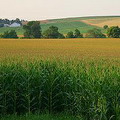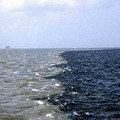死亡海域創新高並持續擴大 肇因鉅量肥料污染
 2008年墨西哥灣的死海區(dead zone)面積又要創下最高紀錄,聯邦與國家科學家7月15日表示,美國的玉米產量遽增是使情況惡化的罪魁禍首。
2008年墨西哥灣的死海區(dead zone)面積又要創下最高紀錄,聯邦與國家科學家7月15日表示,美國的玉米產量遽增是使情況惡化的罪魁禍首。
死海區指一個含氧量不足以維繫水生生物生存的水域。研究團隊預測,2008年夏天死海區將達到22791平方公里,大約是紐澤西州的大小(台灣面積約36000平方公里)。
美國國家海洋大氣總署(the U.S. National Oceanic Atmospheric Administration, NOAA)、路易斯安那大學海洋協會(Louisiana Universities Marine Consortium)與路易斯安那州立大學(LSU)預測死海區會達到自1985年官方監管以來的最大範圍。
美國最大河密西西比河灌溉了美國境內40%的土地,包括大部分農業中心地帶和玉米帶,帶著豐沛營養的河水,每年就在路易斯安那州和德州海岸線外匯集成死海區。更北邊的明尼蘇達州因肥料中的氮與磷流入河流和墨西哥灣,造成海藻增長過度,過量的海藻死亡沉入水底被細菌分解耗掉大量氧氣,造成其他水生生物的缺氧。
美國國家大氣總署沿岸海域研究贊助中(NOAA Center for Sponsored Coastal Ocean Research)執行長梅格尼(Rob Magnien)表示:「肥料和死海區的強烈關連指出,春季從密西西比河流下的過多肥料,是造成死海區擴張的主要人為因素。」2007年死海區已達到7900平方英哩,但一項2002年的紀錄顯示那時死海區總面積就有8500平方英哩之大。
帶領研究團隊的路易斯安那州立大學科學家透納(Eugene Turner)表示,美國中西部前所未有的玉米產量明顯使問題惡化,農夫種植太多的玉米和大豆,讓氮容易藉著作物滲入土壤並污染地下水。
由於玉米生質酒精需求,美國境內玉米產量近年來急遽增加,美國農業部估計2008年增植了8700萬公頃的玉米田。
 美國地質調查局(U.S. Geological Survey, USGS)指出,4月到6月間,81.7萬公噸的氮加速流入墨西哥灣,比往常多了約35~45%。這期間流入墨西哥灣的磷也創新紀錄,共有8.5萬公噸,比往常多了85%。
美國地質調查局(U.S. Geological Survey, USGS)指出,4月到6月間,81.7萬公噸的氮加速流入墨西哥灣,比往常多了約35~45%。這期間流入墨西哥灣的磷也創新紀錄,共有8.5萬公噸,比往常多了85%。
透納表示:「這是因為土地使用改變所致,我們將必須減低水區旁的氮肥使用量。」他建議農夫移除多年生的作物,因為它們將導致土壤過度使用而貧瘠以及水患風險。然而由於已存於土壤中的氮還會長年地持續滲透,即使減量也無法立即挽救現況。
另外,先前在2月,包括美國國家玉米農公會(National Corn Growers Association, NCGA)的種植者們、保育組織、企業與整個農業供應線就已經共同合作,首開先例組成一個以開創農業的永續經營為目標的工作團隊。
This year's dead zone in the Gulf of Mexico is likely to be the largest on record and growing U.S. corn production is a primary cause of the worsening conditions, federal and state scientists said Tuesday.
The research team predicts that the dead zone - a stretch of water without enough oxygen to support marine life - could cover some 8,800 square miles this summer, an area roughly the size of the state of New Jersey.
The forecast was announced today by scientists with the U.S. National Oceanic Atmospheric Administration, NOAA, Louisiana Universities Marine Consortium and Louisiana State University, LSU, who predicted the dead zone would be the largest since official monitoring began in 1985.
The dead zone forms annually off the coasts of Louisiana and Texas, fed by nutrient heavy water from the Mississippi River. The country's largest river drains some 40 percent of the United States, including much of its agricultural heartland and its corn belt.
From as far north as Minnesota, runoff water laden with fertilizer nutrients nitrogen and phosphorous flows into river and into the Gulf, stimulating an overgrowth of algae. When the algae die, they sink to the bottom and decompose, depleting oxygen levels in the water and choking out marine life.
"The strong link between nutrients and the dead zone indicates that excess nutrients from the Mississippi River watershed during the spring are the primary human-influenced factor behind the expansion of the dead zone," said Rob Magnien, director of the NOAA Center for Sponsored Coastal Ocean Research. Last year's dead zone reached some 7,900 square miles, but the record came in 2002, when the area totalled nearly 8,500 square miles.
Record corn harvests throughout the Midwest are clearly adding to the problem, according to Eugene Turner, a scientist with LSU, and leader of the research team.
U.S. farmers are planting "an awful lot of corn and soybeans," he told reporters, adding that both crops leach nitrogen easily into soil and groundwater.
Corn production in the United States has shot up dramatically in recent years, driven by demand for corn-based ethanol. The U.S. Agriculture Department estimates some 87 million acres of corn were planted this year.
Some 817,000 tons of nitrogen, roughly 35-45 percent above normal, seeped into the Gulf between April and June, according to the U.S. Geological Survey, USGS.
Added to the mix is a record amount of phosphorous flowing into the Gulf.
The USGS reported that 85,000 tons of phosphorous entered the Gulf from April through June, some 85 percent above normal levels.
"It is going to have to come from changes in land use," Turner said. "We will have to reduce the amount of nitrogen coming off the watershed."
He suggested farmers move away from perennial crops that leave the land barren and susceptible to flooding, but warned that reductions in nutrient runoff will not yield instant results. Nitrogen is stored in the soil and can continue leaching for many years.
In February, NCGA corn growers, conservation organizations and companies throughout the agriculture supply chain teamed up to launch a first-of-its-kind working group to help establish sustainable outcomes for agriculture.
全文及圖片詳見:ENS




